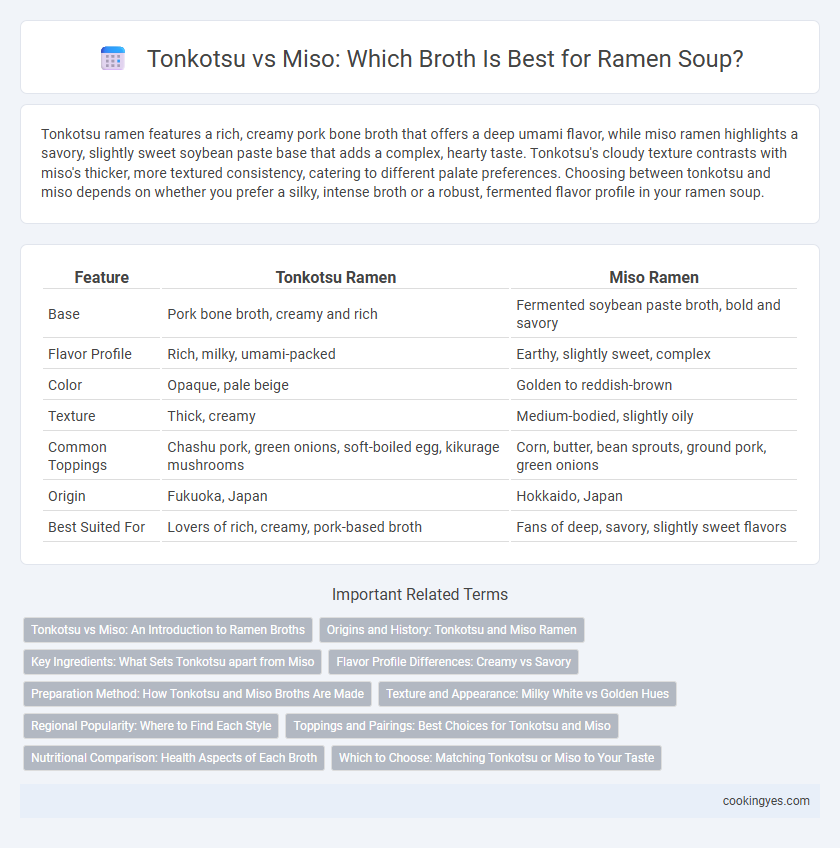Tonkotsu ramen features a rich, creamy pork bone broth that offers a deep umami flavor, while miso ramen highlights a savory, slightly sweet soybean paste base that adds a complex, hearty taste. Tonkotsu's cloudy texture contrasts with miso's thicker, more textured consistency, catering to different palate preferences. Choosing between tonkotsu and miso depends on whether you prefer a silky, intense broth or a robust, fermented flavor profile in your ramen soup.
Table of Comparison
| Feature | Tonkotsu Ramen | Miso Ramen |
|---|---|---|
| Base | Pork bone broth, creamy and rich | Fermented soybean paste broth, bold and savory |
| Flavor Profile | Rich, milky, umami-packed | Earthy, slightly sweet, complex |
| Color | Opaque, pale beige | Golden to reddish-brown |
| Texture | Thick, creamy | Medium-bodied, slightly oily |
| Common Toppings | Chashu pork, green onions, soft-boiled egg, kikurage mushrooms | Corn, butter, bean sprouts, ground pork, green onions |
| Origin | Fukuoka, Japan | Hokkaido, Japan |
| Best Suited For | Lovers of rich, creamy, pork-based broth | Fans of deep, savory, slightly sweet flavors |
Tonkotsu vs Miso: An Introduction to Ramen Broths
Tonkotsu ramen broth is a rich, creamy soup made by simmering pork bones for hours, resulting in a savory umami flavor with a thick, hearty texture. In contrast, Miso ramen broth features fermented soybean paste, offering a robust, slightly sweet and tangy taste with a lighter, more aromatic profile. Both broths exemplify distinct regional Japanese flavors, with Tonkotsu originating from Kyushu and Miso ramen dating back to Hokkaido.
Origins and History: Tonkotsu and Miso Ramen
Tonkotsu ramen originated in Fukuoka, Japan, featuring a rich, creamy pork bone broth developed in the early 20th century as a hearty meal for laborers. Miso ramen, created in Hokkaido during the 1960s, incorporates fermented soybean paste, reflecting local agricultural products and offering a robust, umami flavor. Both styles highlight regional ingredients and culinary traditions, shaping their distinct tastes and cultural significance in Japanese cuisine.
Key Ingredients: What Sets Tonkotsu apart from Miso
Tonkotsu ramen features a rich, creamy pork bone broth, simmered for hours to extract collagen and marrow, creating its signature milky texture. Miso ramen, on the other hand, uses fermented soybean paste as its key ingredient, lending a robust, savory, and slightly tangy flavor profile. While Tonkotsu emphasizes a deep, fatty umami from pork bones, Miso highlights the complex, earthy notes from soybean fermentation, making each broth distinct in taste and nutritional composition.
Flavor Profile Differences: Creamy vs Savory
Tonkotsu ramen features a rich, creamy broth made from simmered pork bones, delivering a deep, umami-packed flavor with a silky texture. Miso ramen offers a savory, slightly tangy broth derived from fermented soybean paste, balancing earthiness with a subtle sweetness. The creamy tonkotsu emphasizes richness and smoothness, while miso highlights complex, robust savory notes.
Preparation Method: How Tonkotsu and Miso Broths Are Made
Tonkotsu broth is crafted by boiling pork bones for 12 to 18 hours, extracting a rich, creamy texture packed with collagen and umami flavors. Miso broth combines fermented soybean paste with chicken or vegetable stock, offering a savory, slightly sweet profile through a shorter simmering process. The intensive bone boiling in Tonkotsu yields a thick, opaque soup, while Miso's method produces a lighter, yet deeply flavored broth.
Texture and Appearance: Milky White vs Golden Hues
Tonkotsu ramen soup features a rich, creamy texture with a milky white appearance derived from pork bone broth simmered for hours, creating a smooth and velvety mouthfeel. In contrast, miso ramen presents a thicker, heartier texture accompanied by golden hues, resulting from fermenting soybeans that add depth and a slightly grainy consistency. The visual distinction highlights tonkotsu's opaque creaminess versus miso's translucent warmth, influencing flavor perception and overall dining experience.
Regional Popularity: Where to Find Each Style
Tonkotsu ramen, characterized by its rich pork bone broth, dominates Kyushu, particularly Fukuoka, where its creamy texture and intense flavor attract locals and tourists alike. Miso ramen, with its savory fermented soybean paste base, is a staple in Hokkaido, especially Sapporo, reflecting the region's colder climate and preference for heartier, warming soups. Each style's regional popularity highlights Japan's diverse culinary landscape and offers distinct taste experiences rooted in local ingredients and traditions.
Toppings and Pairings: Best Choices for Tonkotsu and Miso
Tonkotsu ramen features rich, pork-based broth best paired with toppings like chashu pork, soft-boiled eggs, and sauteed mushrooms to complement its creamy texture. Miso ramen's savory, fermented soybean broth pairs well with corn, butter, ground pork, and green onions that enhance its robust, umami flavor. Both soups benefit from bamboo shoots and nori, but choosing toppings that balance the broth's intensity creates the most harmonious taste experience.
Nutritional Comparison: Health Aspects of Each Broth
Tonkotsu ramen broth, rich in pork bone collagen, provides a high protein content but tends to be higher in fat and calories compared to miso broth. Miso ramen offers benefits from fermented soybean paste, supplying probiotics and essential vitamins like B12, along with lower fat content and antioxidants. Choosing between Tonkotsu and Miso depends on dietary priorities: Tonkotsu supports collagen intake and muscle repair, while Miso boosts gut health and immune function through fermentation nutrients.
Which to Choose: Matching Tonkotsu or Miso to Your Taste
Tonkotsu ramen features a rich, creamy pork bone broth with deep umami flavors, ideal for those who enjoy hearty, savory tastes. Miso ramen offers a robust, slightly sweet, and tangy profile derived from fermented soybean paste, perfect for fans of bold, complex flavors. Choose Tonkotsu for a velvety texture and intense pork essence, or Miso for a balanced, flavorful experience with a hint of sweetness.
Tonkotsu vs Miso for ramen soup Infographic

 cookingyes.com
cookingyes.com